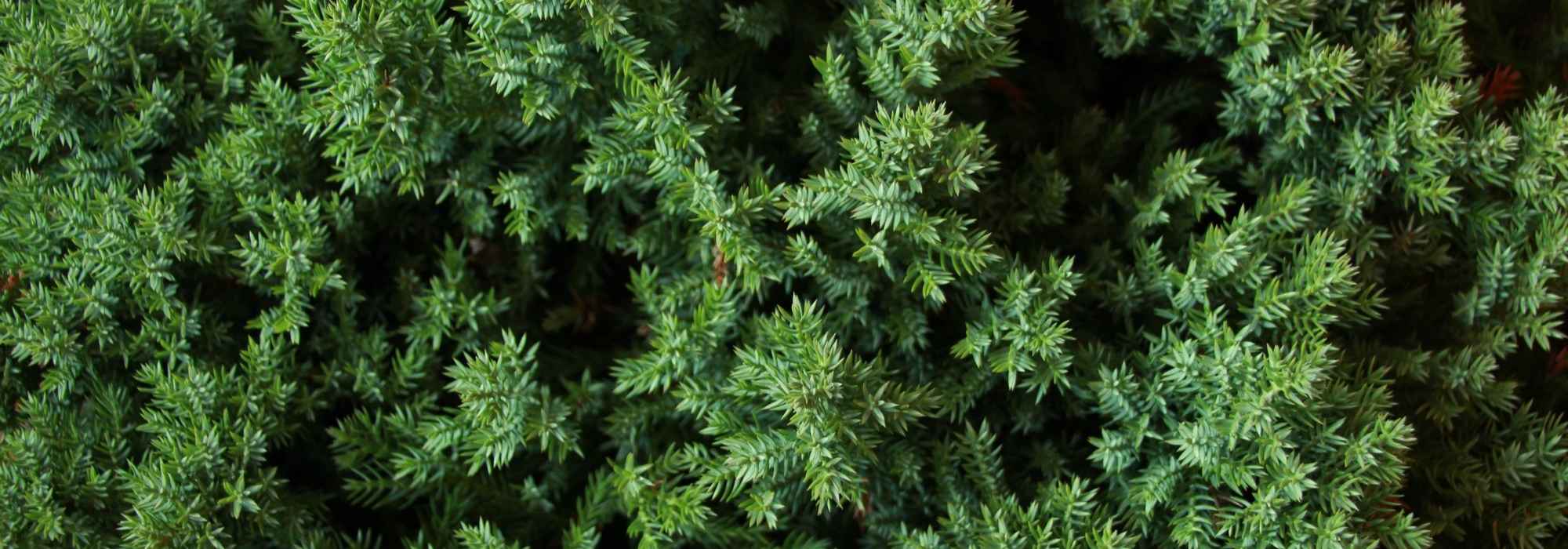
Juniperus, Junipers: planting, pruning and care
Contents
Juniperus, in a nutshell
- Junipers are shrubby conifers, prostrate, spreading, creeping or upright, offering a wide choice of habits as well as foliage colours and textures.
- They are characterised by aromatic foliage made up of needles or scales, and by small fleshy fruits that resemble berries marked with scars, sometimes used to flavour pâtés or sauerkraut.
- They are very undemanding, resistant to heat and summer drought for most species, and tolerant of calcareous (lime-rich) soils.
A word from our expert
Junipers or Juniperus, with their compact upright or spreading silhouette, offer a durable, reassuring structural presence. These bushes with evergreen foliage enjoy great longevity and robustness, making them reliable allies. They also lend themselves to fanciful pruning such as cloud pruning or niwaki, which can be started even on older specimens you want to revamp. Their slow growth is another advantage if little time is to be devoted to pruning.
The variety of textures, spiky or feathery, and colours of Juniperus allow plenty of scope for creating an original setting whether in a contemporary garden, on a terrace or in a naturalistic garden where the light silhouettes of grasses mingle with the ashy-pink tones of heathers. With their compact habit, aromatic foliage in faded tones and rough outlines, they have an exotic quality that transports as easily to Larzac plateau as to mountain summits where the conifer forest gradually gives way to heathland.
Planting a juniper is for the long term because it does not like to be moved, grows fairly slowly and acquires a picturesque silhouette with age. In extreme conditions, the bark of nodose trunks peels away, revealing the grooved white surface of the sapwood that conceals a precious, very hard, reddish heartwood.
Choose its position carefully to mark a path, cover a bank or create a focal point… The advantage is that they adapt to poor soils, provided these are well drained, and tolerate drought, wind (for prostrate forms) and cold very well.
Description and botany
Botanical data
- Latin name Juniperus
- Family Cupressaceae
- Common name Juniper
- Height between 0.15 and 10 m
- Exposure sun
- Soil type any loose, well-drained, even calcareous soil
- Hardiness Excellent (-40 to -15 °C)
Juniperus belong to family Cupressaceae alongside cypresses (Cupressus), false cypresses (Chamaecyparis), Thuja and Calocedrus. Nearly 70 species make up genus if interspecific hybrids encountered in wild are excluded. Like cypresses, junipers are distributed across Old and New Worlds while thujas and false cypresses occur only in North America and Far East. Genus shows great resistance to cold and drought, like pines which often share same open habitat.
These massive trees reaching up to 10 m or erect or spreading bushy shrubs have slow growth and great longevity.
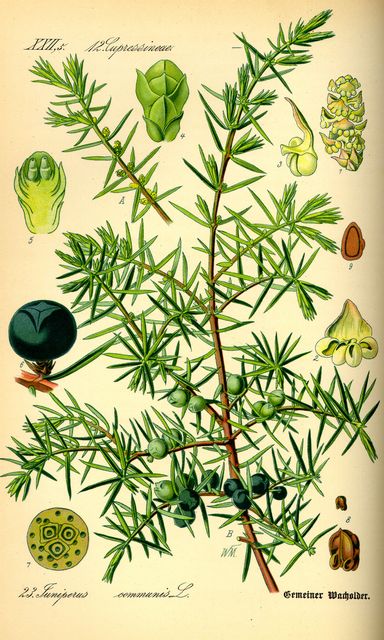
Juniperus communis – botanical illustration
Evergreen foliage appears in two distinct forms, short needles, prickly or not, arranged in threes on shoots as in common juniper (Juniperus communis), or scales opposite two by two applied against the twig as in cypresses. However some species bear both leaf types on same plant, such as Juniperus chinensis; others develop into adult form of scaly leaves after producing needles. In all cases, foliage has aromatic glands that give it gin-like scent when crushed or when warm.
Male and female flowers usually appear on separate plants. Sulphur-yellow aments form small clusters at twig tips. Female flowers take form of miniature cones whose three scales remain fleshy and eventually fuse after fertilization to produce a spherical structure with three seeds. These are called galbulus or false berries and have a bluish-black or reddish hue.
Juniper heartwood (duramen) is also known for strong smell, hardness and reddish colour which contrasts with whiteness of sapwood often visible on old, weathered specimens.
Juniperus essential oil has many medicinal properties, notably antiseptic and diuretic, and is also used in homeopathy.
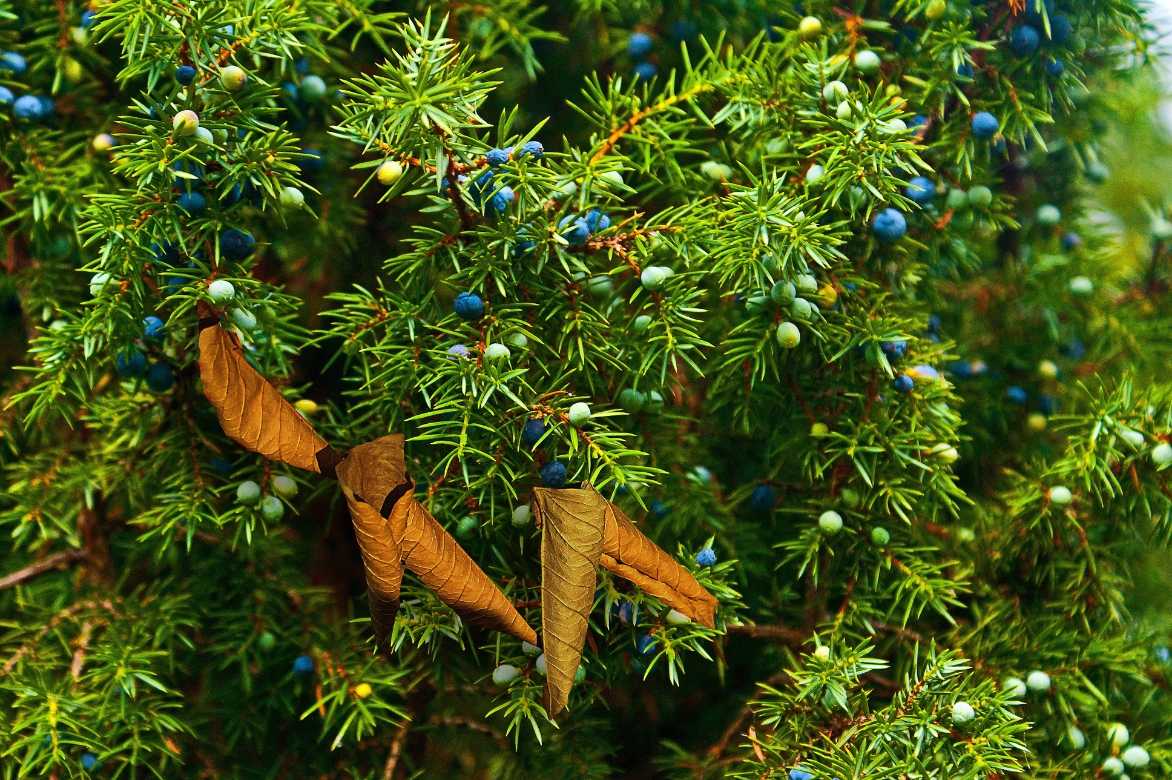
Juniper fruits
Read also
Major diseases and pests of conifersMain varieties of Juniperus
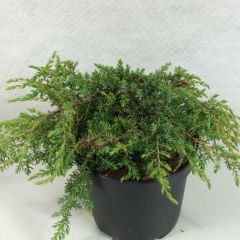
Juniperus communis var. hemisphera Hornibrookii
- Height at maturity 45 cm
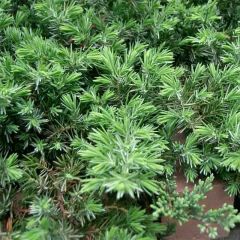
Juniperus rigida subsp. conferta Blue Pacific
- Height at maturity 30 cm
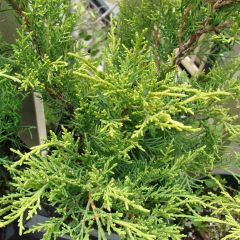
Juniperus x pfitzeriana Old Gold
- Height at maturity 1 m
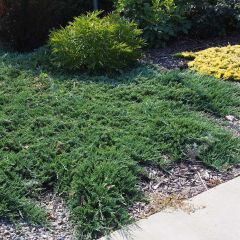
Juniperus horizontalis Wiltonii
- Height at maturity 20 cm
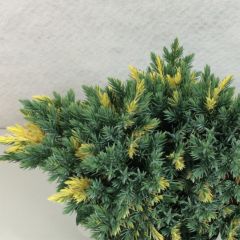
Juniperus squamata Floreant
- Height at maturity 45 cm
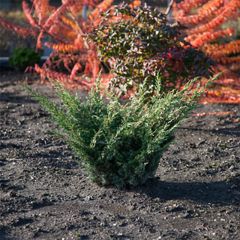
Juniperus Blaauw
- Height at maturity 1,80 m
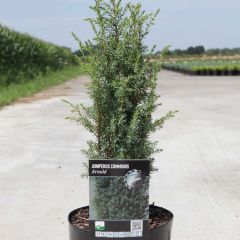
Juniperus communis Arnold
- Height at maturity 2,50 m
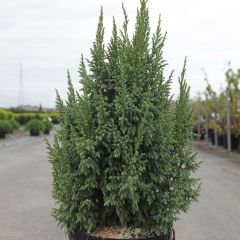
Juniperus squamata Loderi
- Height at maturity 2,50 m
Discover other Juniperus - Juniper
View all →Available in 1 sizes
Available in 2 sizes
Available in 2 sizes
Available in 2 sizes
Available in 1 sizes
Available in 2 sizes
Available in 2 sizes
Available in 2 sizes
Available in 1 sizes
Available in 1 sizes
Planting
Where to plant Juniperus?
Juniper appreciates the full sun and well-drained soil as well as cold climates, even dry in summer, rocky or shallow. Some species are happy by the sea, such as the shore juniper. Plant juniper at sufficient distance from bushes with superficial rooting such as Camellia or from perennials as it could compete directly for water and minerals.
Common junipers in particular have a root system that is superficial, making them vulnerable to strong winds. Choose a spot sheltered from prevailing winds, especially if the bush has an erect habit. Creeping or spreading species present no risk of uprooting.
When to plant?
Plant Juniperus preferably in February–March or in October–November.
How to plant?
This plant presents no difficulty in cold, even dry, climates.
- Dip the bucket into a bucket of water to thoroughly moisten it.
- Dig a hole three times wider than the rootball and loosen soil around with the tines of a garden fork.
- Add a few handfuls of sand and gravel to ensure good drainage around roots. In heavy soil, opt for planting on a raised bed or within a rockery.
- Add well-rotted manure or compost if soil is sandy.
- Place the plant in the planting hole.
- Replace soil and firm gently.
- Water.
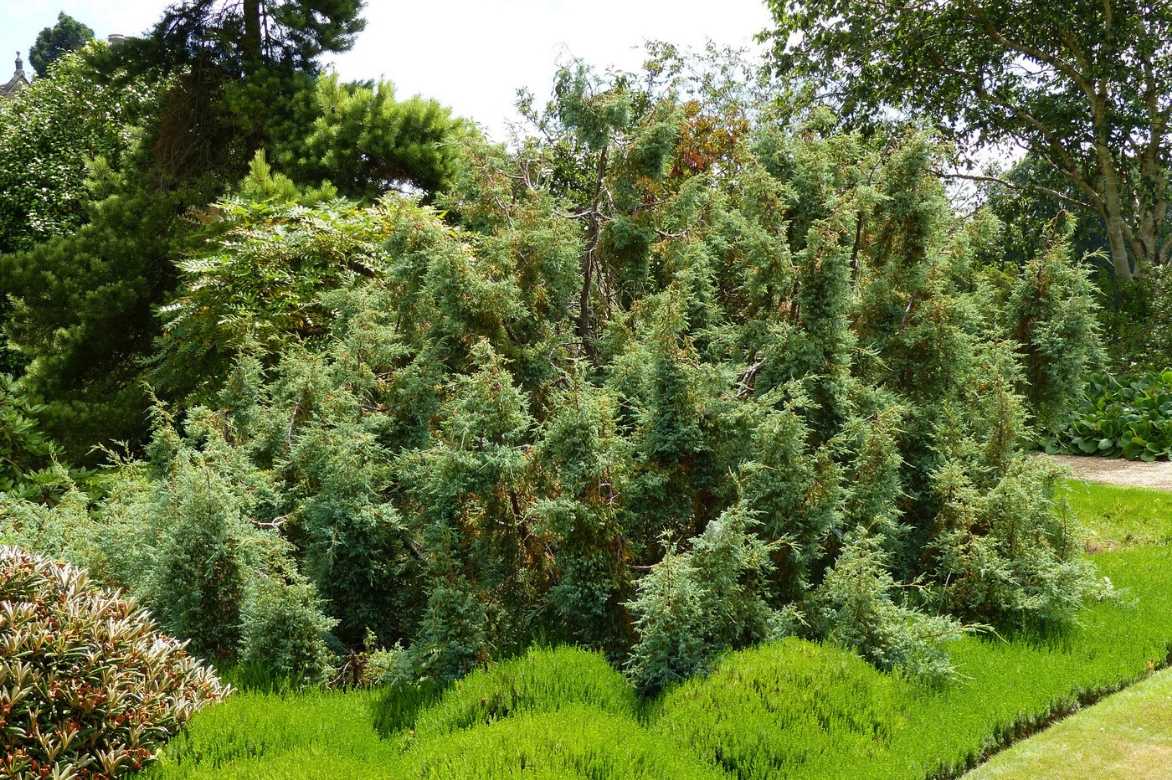
Juniperus squamata ‘Chinese Silver’
Care and pruning
Water during first summer following planting: soil should remain slightly moist to ensure good establishment.
Juniper is not very prone to diseases or pests. Needles that turn slightly yellow then suddenly dry out may, however, indicate an attack by conifer aphids. Spray an insecticidal product such as fern manure, pyrethrin or black soap and repeat application after 8 to 10 days. If branches turn brown, cut them off and burn immediately. Apply copper or a horsetail decoction; it is probably cryptogamic browning.
Juniper pruning
It can be done by removing one-third of this year’s shoots if one wishes to give a more compact habit or delay growth. Bear in mind that if you expose old wood, no regrowth will occur. This is an advantage for cloud training, as you do not need to clean trunks that form bush structure once bush is established. Simply reduce this year’s shoots to maintain the clouds. As in bonsai art, you can train branches into a spiral using wire to instil an atypical shape that will bring charm and uniqueness to the specimen.
Propagation
The simplest method of propagation is to separate layers on creeping forms that spread, often producing roots. Propagation by cuttings remains fairly tricky, and sowing is only possible if your plant is female, produces fruit and is therefore near a male plant of the same species. However, cultivar characteristics will not be reproduced.
Layering
- Start by loosening the soil beneath a low branch.
- Remove leaves from the section of branch to be buried and lightly scrape the bark with your fingernail.
- Sprinkle the wound with plant hormone.
- Bury the portion of branch, leaving the tip exposed and secure it with a metal staple.
- Rooting takes between 12 and 18 months.
- Then sever the layer with pruning shears.
- With a spade, lift the root ball and plant it without delay in a pot or directly in the chosen spot. Discover our tutorial : How to take cuttings from conifers?
Uses and companion plants
Because of their slow growth, junipers are perfect candidates to fill large rockeries or to structure a garden, mark pathways, form borders like boxwood, which is currently suffering many ills, or holly, which is more costly.
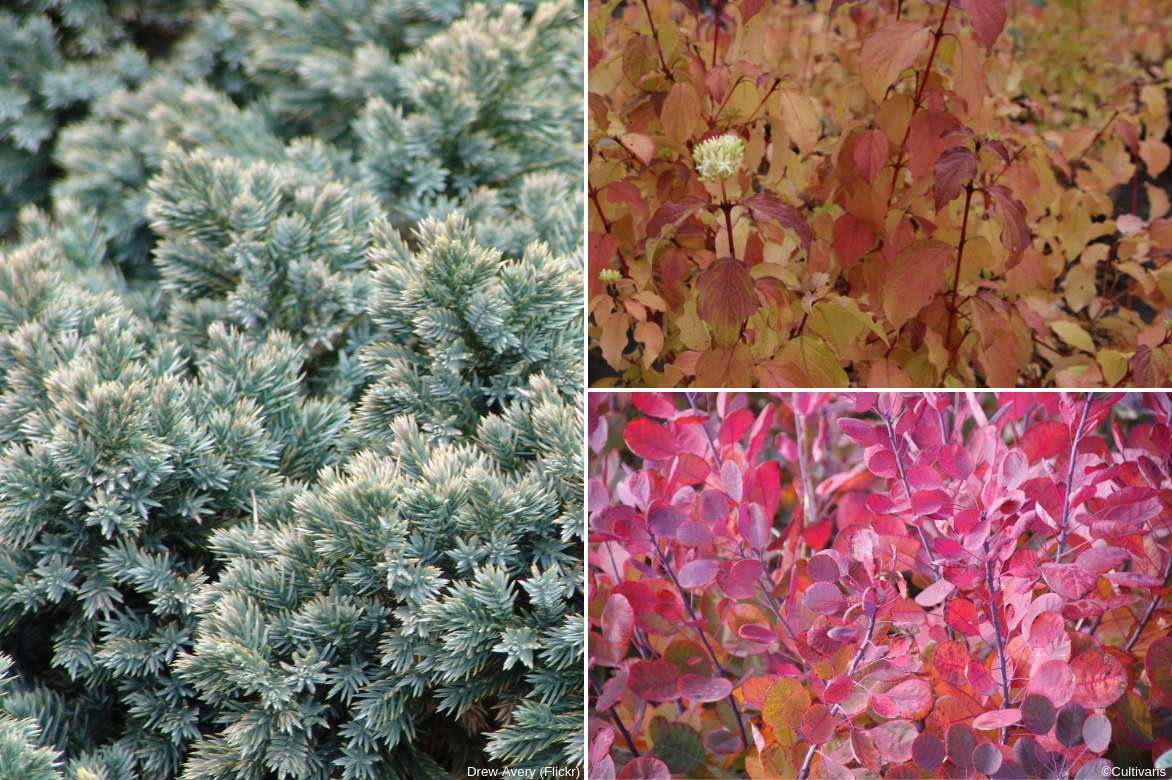
An autumn pairing idea: Juniperus squamata ‘Blue Star’, Cornus sanguinea ‘Winter Beauty’ and Cotinus coggygria ‘Lilla’
Columnar forms can be planted singly or in threes to create more impact. Spreading or creeping forms make perfect groundcovers for large areas or hard-to-access zones such as slopes.
You can play with horizontal, vertical and rounded shapes of these small rock garden conifers to create a graphic scene in nuanced tones of greens, grey, blue, even rust or purple in winter for cultivars that redden in the cold.
They also grow very well in pots and tolerate pruning very well, allowing many uses. The true graphic qualities of conifers naturally assert themselves in contemporary garden design, which favours aesthetics of form, silhouette and texture over the parade of flowering.
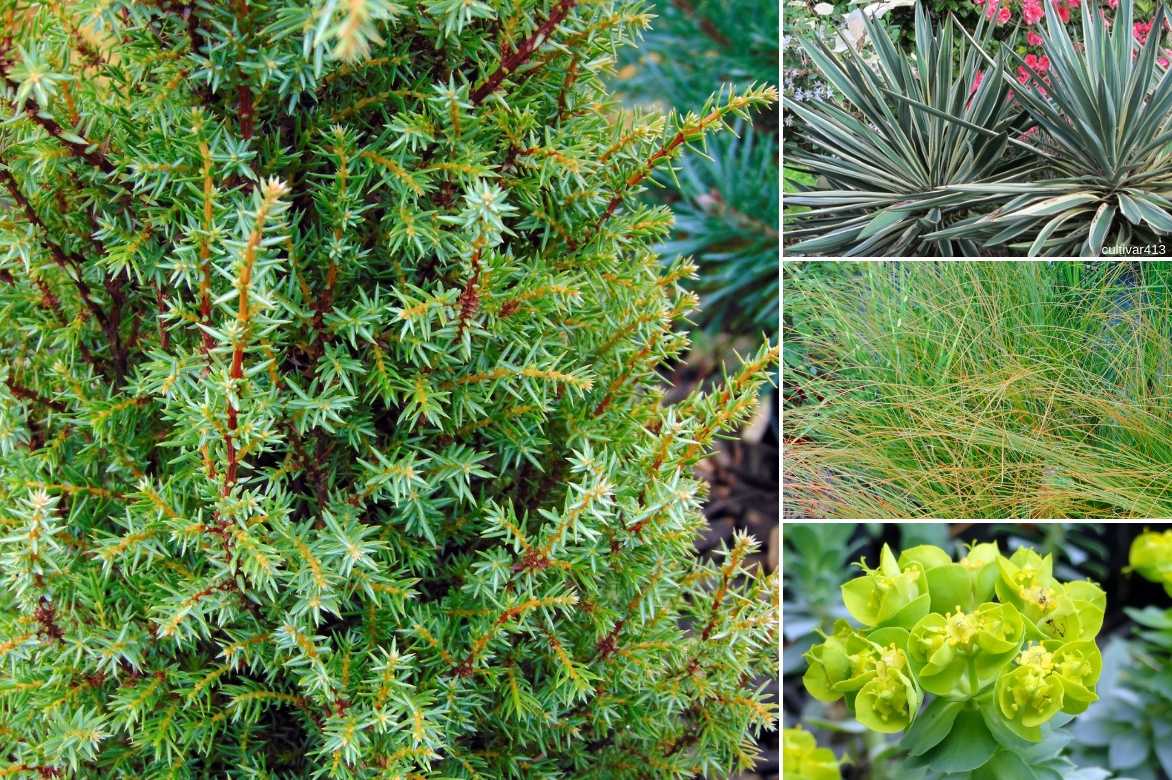
An idea for a slope or large rockery: Juniperus communis ‘Compressa’ (or ‘Arnold’, ‘Gold Cone’ with golden foliage), Yucca gloriosa ‘Variegata’, Carex testacea ‘Prairie Fire’ (in very dry soil, replace with fescues, blue oat grass or Sporobulus) and Euphorbia myrsinites
Juniperus can be planted alongside Mahonias, those bushes with holly-like foliage lit up by perfumed golden-yellow late-winter flowering, heathers whose flowering period can cover all seasons, or scruffy grasses with very complementary character. It is also possible to plant at their base undemanding dry-shade perennial plants such as periwinkles, Euphorbia amygdaloides purpurea, epimediums or Trachystemon orientalis.
To go further
Discover our range of Juniperus: nearly 25 varieties selected for their qualities
Discover our selection of conifers for a Mediterranean garden
Discover our tutorial: How to properly dry and preserve juniper berries
- Subscribe!
- Contents
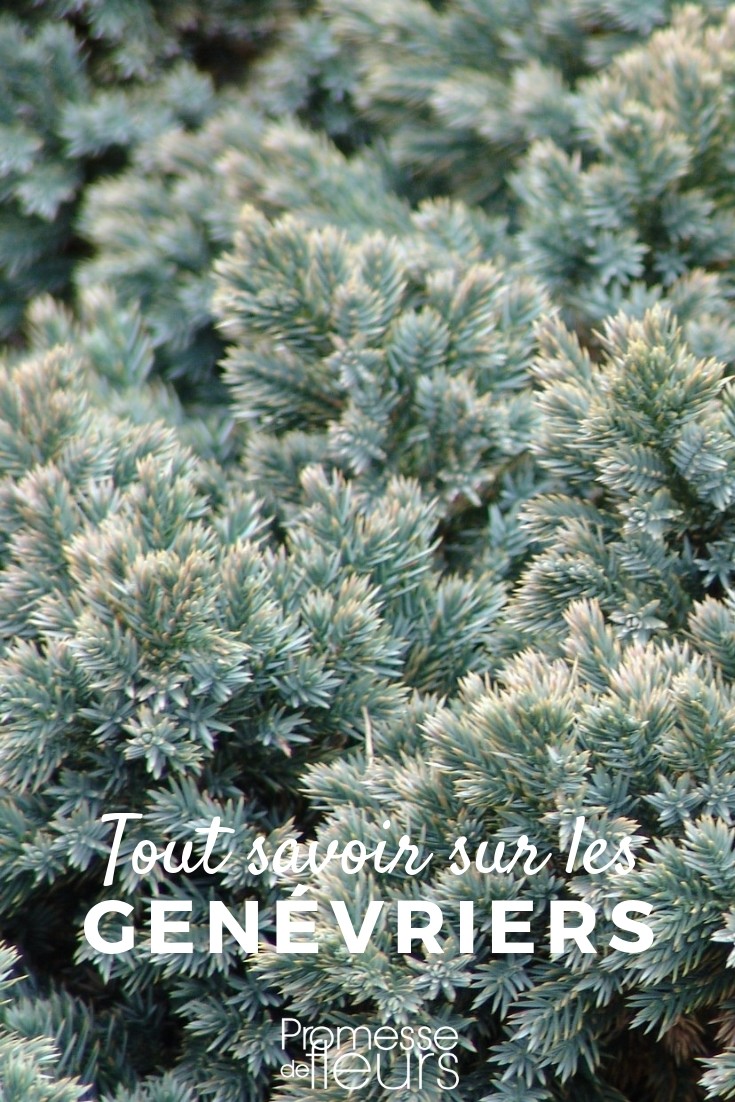































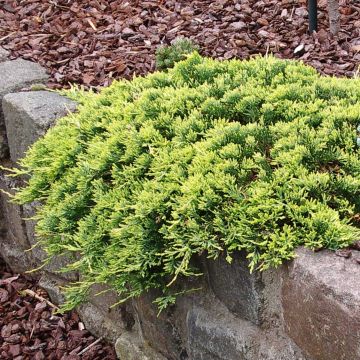
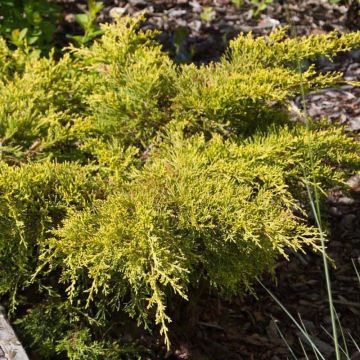
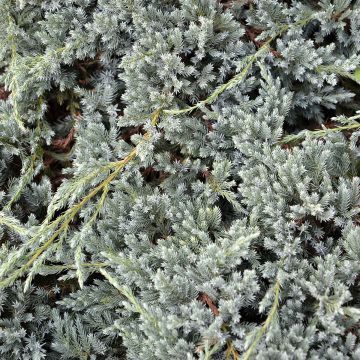

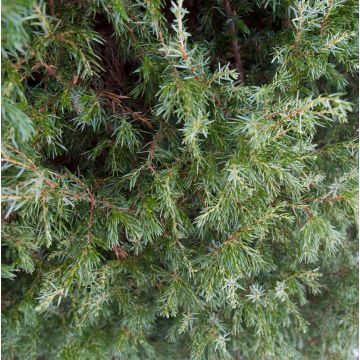
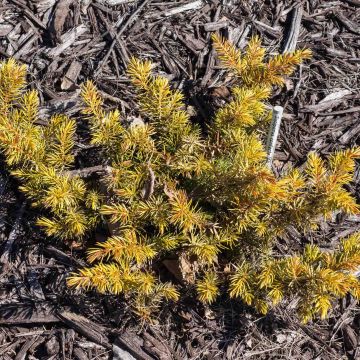
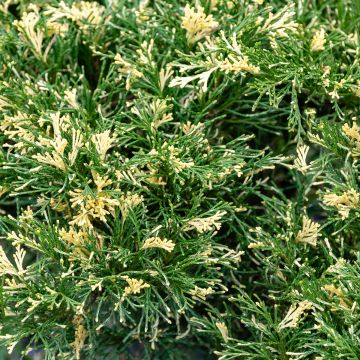

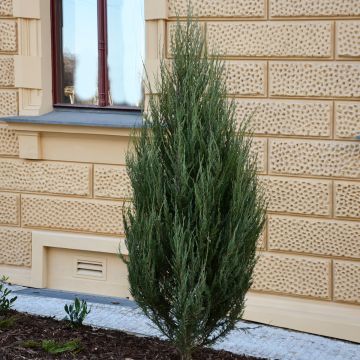
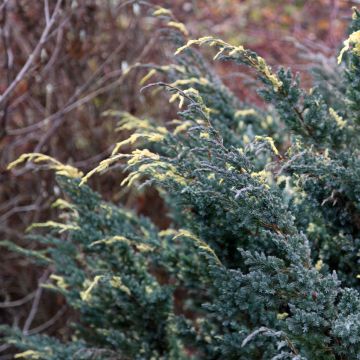
Comments